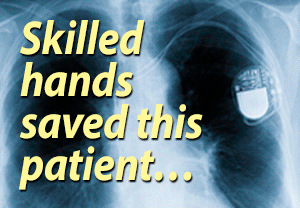 Week 3 - Can PM's cause damage?
Week 3 - Can PM's cause damage?
First of all I just completed week 3 after implant. I had mine for exercise induced heart rate slowing with s.o.b and bradycardia. I stubbornly refused for 3+ yrs to get a PM (I had my symptoms for 5) and now I'm thrilled that I did, sometimes it seems like I got my life back. So anyone else out there in this situation, don't hesitate!
I'm in week 3. My experience seems to have been unremarkable so far compared to many on this site. Maybe I was lucky. Didn't need pain pills, can't tell my regular heart beat from a PM induced one, indeed the only way I know is that when I'm doing my fast walk, my rate does not drop to 90 and get s.o.b.
Questions: I don't see my doc till 6 weeks, there are no real good guidelines between the 2 week strict restrictions and the 2 month all clear. I wish there could be a set of guidelines that define the type of body movement that should be restricted in terms of impact on the device. For instance, can I do dumbell curls with the weight resting on my thigh (light weights)- that's not yanking my shoulders apart.
My other question is that I was surprised to learn that dual chamber PM's can lead to Afib or hospitalization for heart failure due to excess ventricular pacing. I have the latest Medtronic that is designed to reduce this pacing. Can someone point me to some literature on this topic or shed some more light on what the excess pacing refers to ? Thanks for a great site.
8 Comments
More
by Terry - 2008-02-02 01:02:20
The work mentioned in the previous reference has inspired a new way to pace the ventricles that may solve these problems. There are now many hundreds of patients with AV block who have the electrode moved to the heart's conduction system, called the His bundle. It is now standard of practice at some centers. This results in a normal, physiological contraction and provides a better long-term outcome, especially if V-pacing is more than 40%. The idea is to prevent heterogeneity of muscle fiber strain that leads to myofibirlar disarray and local hypertrophy away from the electrode site in response to the increased fiber strian. The heart muscle work in not evenly distributed evenly unless the heart's conduction system is activated. Let me know if you want to see references.
Terry
Studies Say Yes Under Some Conditions
by TwoCents - 2008-02-02 01:02:37
Before I get started I want to let you know that I have copied and pasted an article at the end of this epistle which follows. Apologies for the lengthy post, but this is information that many of us need to have and at least I have not received from my own doctors, but from my own research. I have only recently discovered this disturbing information regarding dual chamber pacemakers. It appears that the problems start when you are paced in the ventricle 40% or more of the time. This is my situation exactly. I pace 100% in the atrium and 40% in the ventricle. If I understand the articles I've read, a dysychronous beat occurs under these circumstances causing the heart to work harder. Over time the heart can enlarge, just like any muscle that does "work". Think of your biceps when you lift weights. When the heart gets larger it is less efficient at pumping. I have already had one bout of CHF two years ago at the age of 58. Now I am 60 and am on my second pacemaker for a total time of 6.5 years. I received my pacemaker on an emergency basis resulting from my sinus node being inadvertently damaged/destroyed during an ill conceived ablation attempt for atrial tachycardia. I try not to dwell on the details as I can do nothing about it and a great deal of pent up anger results which I'm sure is not good for me. Still, I obviously can't quite put the whole thing behind me....hard to do with the little metal guy in my chest keeping me going. In any case here is the copy/pasteversion of a portion of one of the articles which comes from Medscape Cadiology. This is just a portion of the article to keep things brief...to see the whole thing search do a Google search of the title.
More Bad News for Chronic RV Pacing: MOST Substudy Finds Less Is More
June 30, 2003 Recent data add weight to the argument that chronic right ventricular pacing in the dual chamber rate modulated (DDDR) mode produces poor outcomes. The latest findings from a substudy of the MOdeSelection Trial (MOST) indicate that ventricular desynchronization caused by chronic right ventricular pacing in patients with symptomatic sinus node dysfunction (SND) and normal QRS duration increases the risk of heart failure hospitalizations (HFHs) and atrial fibrillation (AF), even when atrioventricular synchrony is preserved.[1] The study was the first to report a strong association between ventricular pacing in the DDDR mode and heart failure in a clinical trial of pacemaker therapy for symptomatic SND. Investigators suggest that preservation of normal ventricular activation through minimal pacing strategies may reduce the risk of HFH and AF, however, they emphasize that further research is warranted.
Data for the current analysis was extracted from stored pacemaker diagnostic data acquired at each follow-up visit during the course of the MOST trial, a 6-year prospective, randomized comparison of single-chamber ventricular rate modulated (VVIR) pacing and DDDR in patients with SND. Percent ventricular paced was determined from stored pacemaker diagnostic data obtained at each follow-up visit (median follow-up of 33.1 months), and cumulative percent ventricular paced (Cum%VP) was calculated for each patient. Baseline QRS duration < 120 ms was observed in 1339 patients; of these, 707 patients (52.8%) were assigned randomly to DDDR and 632 patients (47.2%) were assigned to VVIR. Most patients had normal left ventricular function (median ejection fraction, 55%) and mild or no symptoms of congestive heart failure at baseline.
There is yet another article in the New England Journal of Medicine with the following title which you can search also:
The New England Journal of Medicine.
Volume 357:1000-1008 September 6, 2007 Number 10
Minimizing Ventricular Pacing to Reduce Atrial Fibrillation in Sinus-Node Disease
My intent on this post is not to scare, but to inform. All of us with this situation should press our doctors into explaining this data and hopefully the docs will partner with us to mitigate potential problems caused by our little electronic friends. Remember these problems only pertain to certain conditions...dual chamber, 40% or more of ventricular pacing, DDDR mode, and I'm sure each individual case. Just my TwoCents.
Advocate for Ourselves
by TwoCents - 2008-02-02 03:02:38
Like Canadian Kirk, I too resent discovering these issues on my own. Last time I asked questions about pacemaker function the doc just looked at me with disdain which I read as "Don't worry you're pretty little head about things." Well, I'm the one with the long term consequences and I feel I/we as patients deserve some straight talk. So, I've become my own advocate by learning as much as I can even if it scares me. I don't want my "pretty little head" stuck in the sand. I think we should periodically, on this site, share the science as it becomes available. Step two is to confront our doctors with the science and ask for help in mitigating these unfolding problems. TwoCents
What exactly is ventricular pacing
by axg9504 - 2008-02-02 04:02:10
and how is it different from normal conduction? The day after I got my Medtronic Adapta I googled it and I read material similar to what the other posters (thanks to you) provided. I think the literature does not say that ventricular pacing is bad per se, but it is bad when it is not needed (I don't fully understand what a not needed condition is but it is my understanding that the old single ventricular leads paced all the time).
At week one the pacemaker monitor reported that I was paced 60/30. I expect this to be different next time since I'm doing more walking and my problems requiring a PM always start with exercise.
I don't think I could go back to the non-PM days. My situation was elective, it was not life threatening. I would just have to be a couch potato which would probably have been worse.
More Discussion
by TwoCents - 2008-02-02 05:02:43
Regarding biventricular pacing....as I understand it, and those with more knowledge can feel free to correct me....biventricular pacing is also called resynchronization, meaning that it can be used as the "fix" for people with CHF resulting from some heart conditions as well as CHF resulting from long term pacing effects of right ventricular pacing. It supposedly corrects the dyschronization of the one ventrical (right)pacing being out of whack (scientific term) with the atrial paced contractions which as I previously said causes the heart to work harder against a closed valve. Resynchronization therapy (biventricular pacing) is relatively new and I think in my perusings I have read that there may be some negative consequences coming to light with this type of pacing as well. School's still out. I guess my question to docs would be is switching from a dual chamber pacemaker to a biventricular an option. I would be willing to bet that protocols at this point would require that the patient be in chronic CHF to qualify, but my question as a patient would be should switching to this type be thought of as a prophalaxis for CHF and atrial fibrilation developing over the course of time from the effects of DDDR mode with pacing in the ventricles greater than 40%.
For axg954---From what I understand, long term right ventricular pacing is not good over time, however, it is needed by some of us. In my case, it's my "backup" system in case something happens to my atrial pacing since I have sinus node arrest/atrial standstill. What I don't clearly understand is why I pace 40% plus in the ventricles and what types of programming or meds could cause that percentage to be less. TwoCents
Afib after getting pacemaker
by VonnieVern - 2008-02-02 07:02:09
As much as I'm aware of it, I never had an atrial fibrillation episode until two months after I got my pacemaker. I'm now taking coumadin because of that episode. Is it reasonable to consider the possibility that this was caused by my pacemaker? How would you pose this question to a doctor?
Vonnie
Leads to afib?
by heckboy - 2008-02-02 11:02:42
Where can I learn more about that? What about a duel chamber leads to this?
You know you're wired when...
You trust technology more than your heart.
Member Quotes
Good luck with your surgery. It will improve life amazingly.

.png)



Right Ventricular Pacing: Long term effects
by CanadianKirk2 - 2008-02-02 01:02:03
I am solely right ventricular paced (50% of the time) due to the fact that my atrial lead did not properly seat and has been shut off. At least two doctors have told me that ventricular pacing is all I need. I resent having to be the one to find out on my own that right ventricular pacing IS NOT an ideal situation as well described above by TwoCents and also in this letter (see below) from a Medronic VP that I found two weeks ago on the internet. The language is best understood by a doctor but I think you will get the gist of it. I have an appointment with a specialist coming up and you can be sure the question about the long term effects of right ventricular pacing on my health will be at the top of my list. CanadianKirk
July, 2004
Subject: Reevaluating Conventional Pacing
Dear MD:
In recent years we have witnessed the gratifying and remarkable benefits of biventricular pacing in patients with heart failure both from the hemodynamic standpoint of restoring ventricular synchrony, and in their quality of life.
As new approaches to and indications for device implantation are researched, a significant development is unfolding. A growing body of evidence suggests that chronic RV apical pacing is associated with a variety of adverse effects in patients, particularly those with intact or intermittent atrial-ventricular conduction. Studies have demonstrated that atrial fibrillation (AF), left ventricular dysfunction, and congestive heart failure may either arise or be exacerbated by the mechanical dyssynchrony and ventricular chamber dysfunction that occur with chronic, right ventricular apical stimulation.
Several large, prospective, randomized trials, including the Danish Study, CTOPP, MOST Sub-Study, and DAVID, consistently either directly or indirectly show benefits of preserving intrinsic AV conduction or the intrinsic ventricular activation sequence whenever possible.
Medtronic feels it is imperative to take direction from the studies that suggest that clinical efforts be taken to promote intrinsic conduction, significantly decreasing unnecessary RV pacing. Selective stimulation sites and novel pacing algorithms or modes should be considered when establishing optimal pacing strategies for patients with pacemakers and ICDs.